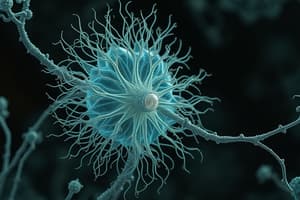Podcast
Questions and Answers
What are the four essential components that form the foundation of life according to the text?
What are the four essential components that form the foundation of life according to the text?
- DNA, Proteins, NADH, ATP
- Organs, Hormones, Enzymes, Antibodies
- Cells, RNA, Fats, Carbohydrates
- Cells, Heredity, Energy, Biological Molecules (correct)
Which of the following is NOT a function of cells as described in the text?
Which of the following is NOT a function of cells as described in the text?
- Producing energy for all living organisms (correct)
- Encapsulating genetic material
- Synthesizing proteins and nucleic acids
- Sustaining life processes
How do prokaryotic and eukaryotic cells differ structurally?
How do prokaryotic and eukaryotic cells differ structurally?
- Eukaryotes lack defined nuclei while prokaryotes have them. (correct)
- Prokaryotes encapsulate genetic material within a nucleus.
- Eukaryotes lack mitochondria compared to prokaryotes.
- Prokaryotes synthesize proteins via translation of mRNA.
What is the role of heredity in living organisms?
What is the role of heredity in living organisms?
Where is genetic material typically found within a cell?
Where is genetic material typically found within a cell?
What are the three stages of cellular respiration?
What are the three stages of cellular respiration?
Which scientist laid the groundwork for understanding hereditary patterns?
Which scientist laid the groundwork for understanding hereditary patterns?
What is the primary function of enzymes in biological systems?
What is the primary function of enzymes in biological systems?
What is the main focus of ecology as a branch of biology?
What is the main focus of ecology as a branch of biology?
Which of the following is a promising avenue for advancing knowledge in biology according to the text?
Which of the following is a promising avenue for advancing knowledge in biology according to the text?
Flashcards are hidden until you start studying
Study Notes
Introduction
Biology is the natural science dedicated to studying all forms of living organisms, from bacteria to humans. It explores structure, function, growth, reproduction, behavior, development, interactions with each other and the environment, and the history of life on Earth. Understanding the intricate mechanisms within biological systems is critical for numerous realms, ranging from medicine to agriculture and environmental conservation.
Key Components of Life
The foundation of life revolves around four essential components: cells, heredity, energy, and biological molecules. Cells are the fundamental units of life, serving as the building blocks for all living organisms. Heredity, governed by DNA and genes, determines how traits are passed down across generations. Energy, sourced from nicotinamide adenine dinucleotide (NADH) and adenosine triphosphate (ATP), powers all life processes. Finally, biological molecules, primarily proteins and nucleic acids, execute various functions integral to survival.
Cells
Cells are small, membrane-bound compartments that encapsulate the essence of life. They contain genetic material—DNA, and are responsible for carrying out myriad metabolic processes needed to sustain life. Prokaryotic and eukaryotic cells differ structurally: prokaryotes lack defined nuclei, while eukaryotes harbor nuclear and mitochondrial boundaries. Both types house proteins synthesized via translation of messenger RNA (mRNA).
Cellular Processes
Cellular respiration, the process of converting food into energy, occurs in three stages: glycolysis, the citric acid cycle, and oxidative phosphorylation. Glycolysis breaks down glucose into pyruvate, generating NADH, ATP, and carbon dioxide. The citric acid cycle further degrades pyruvate to generate ATP and NADH, while reducing oxygen to water through oxidative phosphorylation.
Heredity
Gregor Mendel's work on pea plants laid the groundwork for our understanding of hereditary patterns. His laws describe the inheritance of traits, revealing that genes are independent of each other and follow dominant/recessive relationships.
Energy
Life requires constant energy input due to its inherently dynamic nature. Organisms acquire energy through ingestion of organic materials, transforming them into ATP through cellular respiration. Metabolism, the sum of all chemical reactions within an organism, continuously generates and utilizes ATP to fuel various cellular processes.
Biological Molecules
Proteins, comprised of chains of amino acids linked by peptide bonds, perform a diverse array of functions. Enzymes catalyze biochemical reactions, structural proteins maintain tissue integrity, and regulatory proteins control gene expression. Nucleic acids, such as DNA and RNA, encode genetic instructions for protein synthesis.
Structure of Proteins
Primary sequence refers to the order of amino acids in a protein chain. Tertiary structure describes the overall spatial arrangement of a protein, shaped by folding around covalent and noncovalent interactions. Quaternary structure pertains to the binding of multiple polypeptides to form multimeric complexes.
Branches of Biology
Biology branches out into several specialized disciplines focused on specific aspects of life. Some notable divisions include botany, zoology, ecology, and microbiology.
Botany
Botany concerns itself with the scientific study of plants, examining plant structures, growth, reproduction, diversity, and interactions with the environment. Techniques used in botanical research include flotation experiments, chromatography, and electrophoresis.
Zoology
Zoology delves into animal ecology, physiology, systematics, and behavior. Studying animal anatomy and physiology helps understand the underlying mechanisms behind their survival strategies.
Ecology
Ecology focuses on the interrelationships among species, populations, communities, and their physical environments. It encompasses topics such as population dynamics, competition, predator-prey relationships, symbiosis, succession, and ecological systems.
Microbiology
Microbiology centers on the study of microorganisms, including viruses, bacteria, archaea, protists, and fungi. Understanding their roles in disease transmission, decomposition, nutrient cycling, and industrial applications is vital.
Future Directions
As technology advances, so does the scope of biological exploration. Genome editing, synthetic biology, and personalized medicine offer promising avenues for advancing knowledge in these domains. Maintaining an awareness of emerging techniques and applying them to address current challenges is paramount for continued progress.
Studying That Suits You
Use AI to generate personalized quizzes and flashcards to suit your learning preferences.




